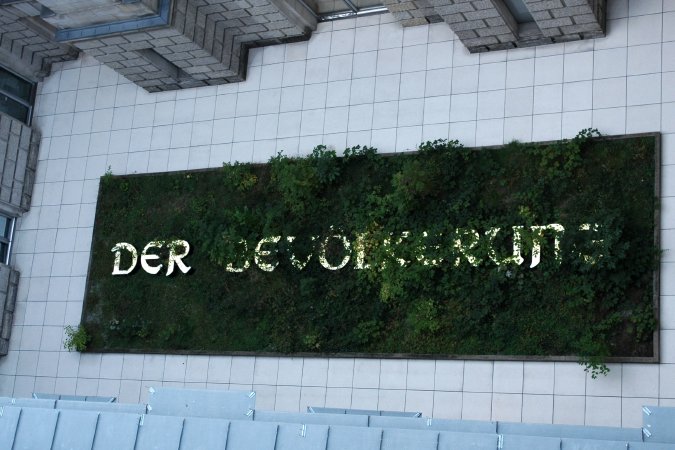Obsession and Desire in Black Is, Black Ain’t
In the age of post-ethnicity, a term coined during the Freestyle show at the Studio Museum in Harlem, the Black Is, Black Ain’t show does not deny the binary racial categorizations of black and non-black, but instead exhibits an apparent obsession with blackness. The exhibit shows a fascination with blackness that pervades our social experience, both accepting and simultaneously rejecting the racial categorization. Unlike Freestyle, the show that served as a cultural landmark to the post-black era, the artists in this exhibition come from diverse racial, political and social backgrounds. The inclusion of non-black, in addition to black, artists allows the exploration of blackness from various points on the cultural spectrum. It also makes for a more diverse approach to aesthetics, instead of the pervasive “black aesthetic” that dominated the majority of shows focusing on blackness. One poignant theme that emerges from the use of diverse artists is the issue of desire regarding blackness, from the perspective of the outsider as well as those immersed in the culture. Desire is represented in various forms; both aesthetically and ideologically. The most obvious form of desire is physical or sexual, but there are also elements of emotional, psychological and intellectual desire exhibited in various works. The majority of artists focusing on desire in relation to blackness are not black. These artists are investigating blackness in relation to racial taboos with an honest, and often personal, approach to ideas of race.
The desire exhibited in these works is not a desire to be black, but instead a psychological desire to understand blackness and a physical desire to “feel” blackness. Tom Johnson’s work, What a Black Man Feels Like, is a monologue performed by the artist in front of the camera, originally exhibited as a live performance piece. The artist speaks of a desire to massage a black man, because black men interest him more that other people. There is an obvious physical desire in relation to blackness in this situation, but the tortured persona of the artist’s inner thoughts reveals that the desire is not only physical. He is obsessed with the idea of black men and the piece functions as a kind of personal diary where he investigates the reasoning behind his fascination and obsession with black men. While the piece may seem wrought with homosexual desire, it goes beyond that into an exploration of the fascination with the “other.” Also the piece is very personal, it also reflects society’s persistent obsession with race.
The post-ethnic era relies on the simultaneous acceptance and rejection of racial categorization. Johnson’s piece reveals that racial distinctions and the identification of racial differences is still very much a part of our social discourse, even if many people choose to keep their fascination private. It also both accepts and rejects physical differences between blacks and non-blacks. He desire to massage a black man implies that there is a tactile difference between the skin of a black man and the skin of other people. This makes the viewer question that difference, and when the viewer realizes that the difference is not tactile, physical or even tangible, the inner struggle to understand racial differentiation emerges. This reinforces the notion that society’s perception of race is a social construct and not based on biological differences.
Joanna Rytel’s intense video, To Think Things You Don’t Want To, delves into the inner struggles of a white, Swedish woman who has a relationship with a black man. The language is abrasive, and not politically correct in any way, but is personal and honest. She explores the taboo desires related to interracial relationships. Again this work is based on the personal desire of the non-black artist, who deals with socio-historical constructs of race, even on the personal level. Racial discriminatory and offensive thoughts are publicly expressed by Rytel. The title of the works announces that the artist knows that she “shouldn’t” have these thoughts, but they are woven into our societal language of race. She admits that she sometimes thinks of her lover as nigger, and as much as she knows it is wrong, the word has been historically integrated into public discourse on race and therefore pervades even her personal relationship. Through this work she admits that the public is not color-blind in relation to race, and even people who are not racist have been socialized into seeing racial differences. She is continuously aware of the perceptions of others and how the public views her interracial relationship. The video represents a failing struggle to deny those public perceptions and the inability to somehow rise above the issue of racial opposition. Although her honesty is often offensive and uses racial slurs and stereotyping, she is making the viewer aware of thoughts that have previously been subconscious. Through her own honest investigation of her perspective on race, she asks the viewer to question if they think similar things that they do not want to think; or admit that they think.

Mickalene Thomas’s Lovely Six Foota (2007) relies on exoticism and stereotypical cultural signifiers of black women to create desire. The photograph depicts an African-American woman, clad in a multi-print dress in a room decorated in 70s décor and leopard print furniture. Thomas is an African-American artist, but she is not denying stereotyped exoticism, but reinforcing it to create a sense of racialized desire. She is creating a hyper-awareness of social stereotyping of black women. The animal patterns refer to cultural codes we associate with African that have been popularized in American culture, and the records in the lower right corner of the photograph are those of African-American musical divas. This reflects a cultural obsession with “black music,” and a desire that is based purely on media’s representation of the black woman. The perspective invites the viewer to look directly up the woman’s skirt, but then is met with darkness, denying the erotic experience. The subject stares directly at the viewer; both inviting them in and creating an unsettling awareness of their position in objectifying her. The sexually charged image creates desire, but the viewer is left to question the basis of that desire, which is created through stereotypical means. (you can see more of Thomas's work here)
The inclusion of non-black artists separates this exhibition from other post-ethnic shows, such as The New Authentics: Artists of the Post-Jewish Generation and Freestyle, because it opens up the discourse about race. Social taboos regarding race and desire are explored from the perspective of both black and non-black artists, which leaves the works at risk of being offensive, yet at the same time reveals the pervasive existence of racial categorization and discrimination. This subliminal element of desire is explored on the personal level, but the personal also mirrors public perceptions of race. The viewer is presented with racial taboos. These taboos are not only represented personally by the artists, but also as an affect of the historical influence on race in the public sphere. This exhibition reinforces one particular issue in the post-ethnic era; the fact that even though race is a socially constructed category, it is still very much a part of the cultural dialogue.





 These works make us question the histories that have been taught to us and how we think about the commodified culture of the "other," which is the way in which we generally experience other cultures. He blends high and low culture by working with everyday materials and imagery, yet questions the way in which our experiences our mediated by our outsider attitude.
These works make us question the histories that have been taught to us and how we think about the commodified culture of the "other," which is the way in which we generally experience other cultures. He blends high and low culture by working with everyday materials and imagery, yet questions the way in which our experiences our mediated by our outsider attitude.  This made me think of Itagaki Yoshio's work, which I don't find particularly interesting, because they are wrought with digital manipulation and seemingly lacking in conceptual investigation, but deals with the same idea of displacement of marginalized or minority cultures. His two projects, "Native American Reservation on the Moon" and "Cyber Amish County," point out the ridiculous nature of pushing people into locations that don't suit their lifestyles and need.
This made me think of Itagaki Yoshio's work, which I don't find particularly interesting, because they are wrought with digital manipulation and seemingly lacking in conceptual investigation, but deals with the same idea of displacement of marginalized or minority cultures. His two projects, "Native American Reservation on the Moon" and "Cyber Amish County," point out the ridiculous nature of pushing people into locations that don't suit their lifestyles and need. 





